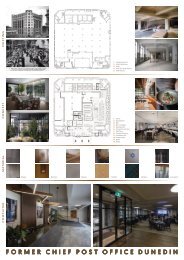Create successful ePaper yourself
Turn your PDF publications into a flip-book with our unique Google optimized e-Paper software.
European Society of
MusculoSkeletal Radiology
Musculoskeletal Ultrasound
Technical Guidelines
II. Elbow
Ian Beggs, UK
Stefano Bianchi, Switzerland
Angel Bueno, Spain
Michel Cohen, France
Michel Court-Payen, Denmark
Andrew Grainger, UK
Franz Kainberger, Austria
Andrea Klauser, Austria
Carlo Martinoli, Italy
Eugene McNally, UK
Philip J. O’Connor, UK
Philippe Peetrons, Belgium
Monique Reijnierse, The Netherlands
Philipp Remplik, Germany
Enzo Silvestri, Italy
Note
Elbow
The systematic scanning technique described below is only theoretical, considering the
fact that the examination of the elbow is, for the most, focused to one quadrant only of the
joint based on clinical findings.
1
For examination of the anterior elbow, the patient
is seated facing the examiner with the elbow in an
extension position over the table. The patient is
asked to extend the elbow and supinate the forearm.
A slight bending of the patient’s body toward
the examined side makes full supination and assessment
of the anterior compartment easier. Full
elbow extension can be obtained by placing a
pillow under the joint.
*
*
Transverse US images are first obtained by
sweeping the probe from approximately 5cm
above to 5cm below the trochlea-ulna joint,
perpendicular to the humeral shaft. Cranial US
images of the supracondylar region reveal the
superficial biceps and the deep brachialis muscles.
Alongside and medial to these muscles,
follow the brachial artery and the median nerve:
the nerve lies medially to the artery.
Legend: a, brachial artery; arrow, median nerve; arrowheads,
distal biceps tendon; asterisks, articular cartilage of the
humeral trochlea; Br, brachialis muscle; Pr, pronator muscle
2
The distal biceps tendon is examined while keeping the
patient’s forearm in maximal supination to bring the
tendon insertion on the radial tuberosity into view. Because
of an oblique course from surface to depth, portions
of this tendon may appear artifactually hypoechoic
if the probe is not maintained parallel to it. Accordingly,
the distal half of the probe must be gently pushed
against the patient’s skin to ensure parallelism between
the US beam and the distal biceps tendon thus allowing
adequate visualization of its fibrillar pattern.
1
Elbow
2
The distal biceps tendon is best examined on its long-axis. Short-axis planes are less useful
to examine the distal portion of the biceps because slight changes in probe orientation
may produce dramatic variation in tendon echogenicity and create confusion between the
tendon and the adjacent artery.
*
Legend: arrows, distal biceps tendon; asterisk, coronoid fossa and anterior fat pad; Br, brachialis muscle; HC, humeral
capitellum; RH, radial head; s, supinator muscle
Follow the short brachialis tendon on long-axis planes down to its insertion on the coronoid
process.
3
!
With medial sagittal planes check the
coronoid fossa which appears as a concavity
of the anterior surface of the humerus
filled with the anterior fat pad. In normal
states, a small amount of fluid may be
seen between the fat pad and the
humerus. On transverse scans, the anterior
distal humeral epiphysis appears as a
wavy hyperechoic line covered by a thin
layer of hypoechoic articular cartilage: its
lateral third corresponds to the humeral
capitellum (round), whereas its medial two
thirds relate to the humeral trochlea (Vshaped).
On sagittal planes, the radial
head exhibits a squared appearance: its
articular facet is covered by cartilage.
Legend: arrow, brachialis tendon; arrowheads, anterior coronoid
recess; asterisks, articular cartilage of distal humeral epiphysis; Br,
brachialis muscle; curved arrow, anterior fat pad; HC, humeral
capitellum; HTr, humeral trochlea
*
*
* *
2
4
%
Moving to the anterolateral elbow, follow the main trunk of the radial
nerve in its short-axis between the brachioradialis and the brachialis
muscle down to its bifurcation into the superficial sensory branch and
the posterior interosseous nerve. Continue to follow these latter nerves
according to their short-axis with meticulous scanning technique.
The posterior interosseous nerve must be demonstrated using shortaxis
planes as it pierces the supinator muscle and enters the arcade
of Fröhse passing between the superficial and deep parts of this
muscle. Evaluation of the posterior interosseous nerve is made easier
by sweeping the probe over the supinator in a transverse plane
while performing forearm pronation and supination.
Legend: arrow, posterior interosseous nerve; arrowhead, cutaneous sensory branch of the
radial nerve; Br, brachialis muscle; BrRad, brachioradialis muscle; curved arrow, main trunk
of the radial nerve; RH, radial head; RN, radial neck; s 1 , superficial head of the supinator
muscle; s 2 , deep head of the supinator muscle
Elbow
#
"
5
$
The lateral aspect of the
elbow is examined with both
elbows in extension, thumbs
up, palms of hands together
or with the elbow in flexion.
The common extensor tendon
is visualized on its longaxis
using coronal planes with
the cranial edge of the probe
placed on the lateral epicondyle.
Short-axis planes should be also obtained over
the tendon insertion. In normal conditions, the
lateral ulnar collateral ligament cannot be separated
from the overlying extensor tendon due to
a similar fibrillar echotexture.
Legend: arrowhead; lateral ulnar collateral ligament; curved arrow, lateral synovial fringe; LE, lateral epicondyle; RH,
radial head; straight arrows, common extensor tendon
3
6
!
Elbow
Check the lateral synovial fringe that fills the superficial portion of the lateral aspect of the
radiocapitellar joint. Dynamic scanning during passive pronation and supination of the
forearm may help to assess the status of the radial head and to rule out possible occult
fractures. With this manoeuvre, check the annular ligament. At the radial neck, the annular
recess is visible only if distended by fluid.
*
Legend: arrowhead; posterior interosseous nerve; asterisk, lateral synovial fringe; curved arrow, common extensor
tendon; LE, lateral epicondyle; RH, radial head; straight arrow, annular ligament
7
&(: )$*
For examination of the medial elbow, the patient is asked to lean toward the ipsilateral
side with the forearm in forceful external rotation while keeping the elbow extended or
slightly flexed, resting on a table. Coronal planes with the cranial edge of the probe placed
over the medial epicondyle (epitrochlea) reveal the common flexor tendon in its longaxis.
The tendon is shorter and larger than the common extensor tendon. Deep to this
tendon, check the anterior bundle of the medial collateral ligament.
&
'
&
'
Legend: arrowheads, common flexor tendon origin; arrows, anterior bundle of the medial
collateral ligament; ME, medial epicondyle
More adequate positioning for examination
of this ligament is obtained
with the patient supine keeping
the shoulder abducted and
externally rotated and the elbow in
90° of flexion. Dynamic scanning
in valgus stress (demonstration of
joint space widening) may be useful
in partial tears, in which the ligament
is continuous but lax.
4
8
+
Elbow
The posterior elbow may be examined by keeping the joint flexed 90° with the palm resting
on the table. Cranial to the olecranon, the triceps muscle and tendon are evaluated
by means of long-axis and short-axis scans. The most distal portion of the triceps tendon
needs to be carefully examined to rule out enthesitis.
Legend: arrowheads, posterior olecranon recess; arrows,
triceps tendon; asterisk, posterior fat pad; TR,
triceps muscle
*
Deep to the triceps, the olecranon fossa and the posterior olecranon recess are evaluated
by means of long-axis and short-axis scans. While examining the joint at 45° flexion,
intraarticular fluid tends to move from the anterior synovial space to the olecranon recess,
thus making easier the identification of small effusions. Gentle rocking motion (backward
and forward) of the patient’s elbow during scanning may be helpful to shift elbow
joint fluid into the olecranon recess. Care should be taken not to apply excessive pressure
with the probe when evaluating the superficial olecranon bursa because small bursal
effusions may be squeezed away.
9
%
For evaluation of the cubital tunnel, the patient’s elbow should be
placed in forceful internal rotation with ex-tended elbow (olecranon
facing the examiner). The ulnar nerve is examined in its short-axis
(long-axis scans are less useful) from the distal arm through the
distal forearm. Care should be taken to identify nerve shape changes
across the epicondylar groove (a) and the cubital tunnel (b).
&
*
Legend: arrow, ulnar nerve; asterisk, triceps tendon; ME, medial epicondyle; O, olecranon process; void arrowhead,
ulnar head of the flexor carpi ulnaris muscle; white arrowhead, humeral head of the flexor carpi ulnaris muscle; 1,
cubital tunnel retinaculum (Osborne ligament); 2, arcuate ligament; 3, flexor carpi ulnaris muscle
5
Elbow
10
%,
Dynamic imaging of the cubital tunnel is performed either with the patient seated and the
elbow placed on a stiff pillow or, at least for the right side, with the patient supine and the
arm abducted, hanging out of the table. The position of the ulnar nerve and the medial
head of the triceps relative to the medial epicondyle is assessed throughout elbow flexion
while placing the probe in the transverse plane with one edge on the olecranon and the
other on the medial epicondyle. During this manoeuvre, it should be emphasized that the
application of firm pressure on the skin with the transducer must be avoided because it
may prevent the anterior dislocation of the nerve from the tunnel.
*
&
*
&
Legend: Ulnar nerve instability. Arrow, ulnar nerve; asterisk, common flexor tendon; ME, medial epicondyle;
mht, medial head of triceps muscle; O, olecranon process. During flexion, the ulnar nerve snaps out of the
cubital tunnel. Ulnar nerve instability is related to the absence of the Osborne retinaculum
6
















